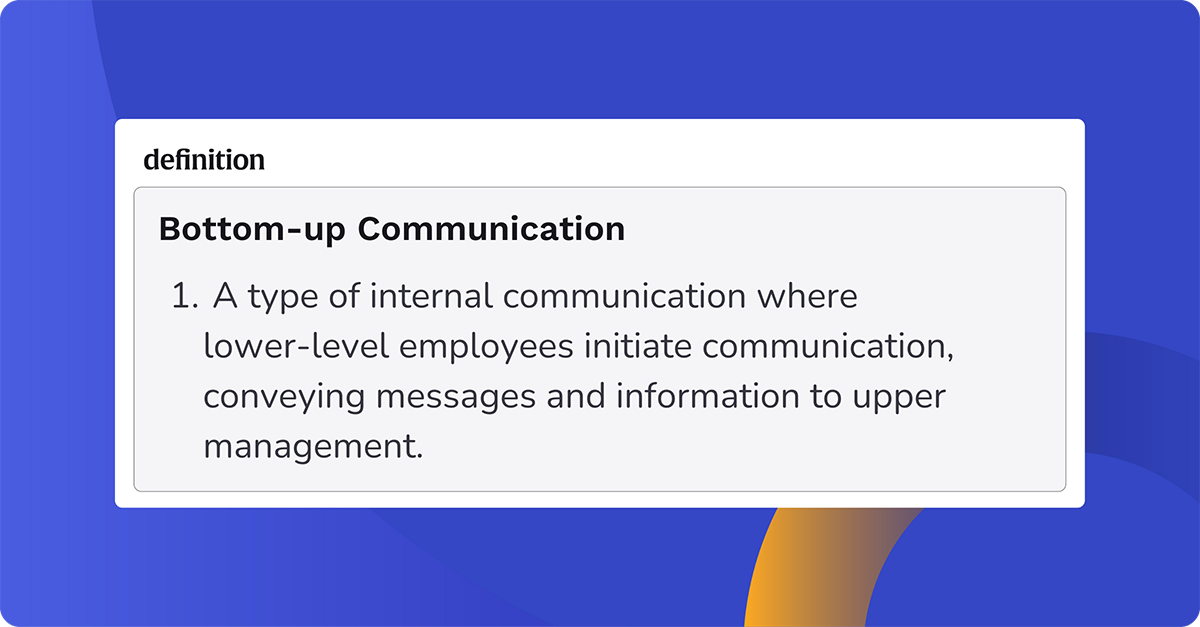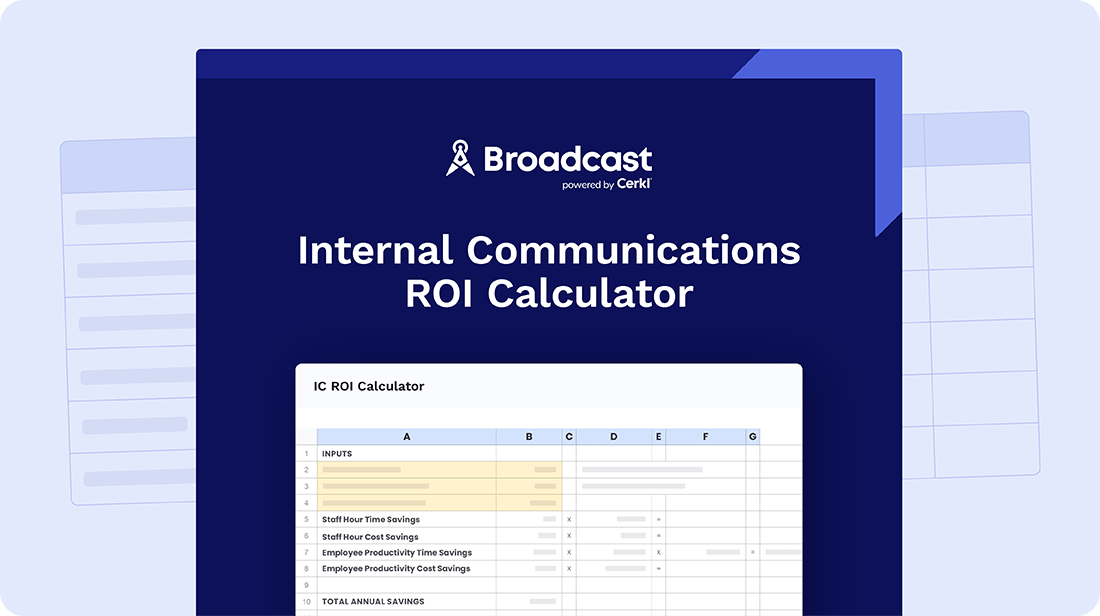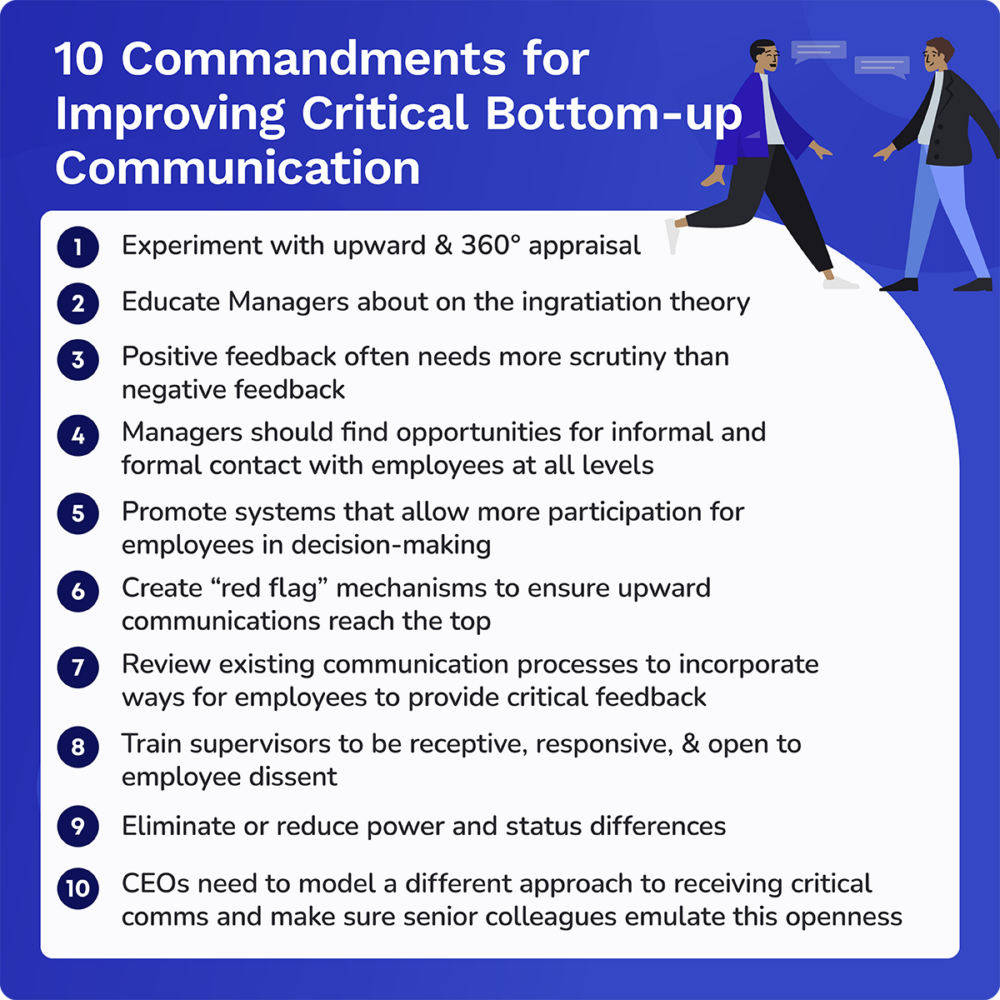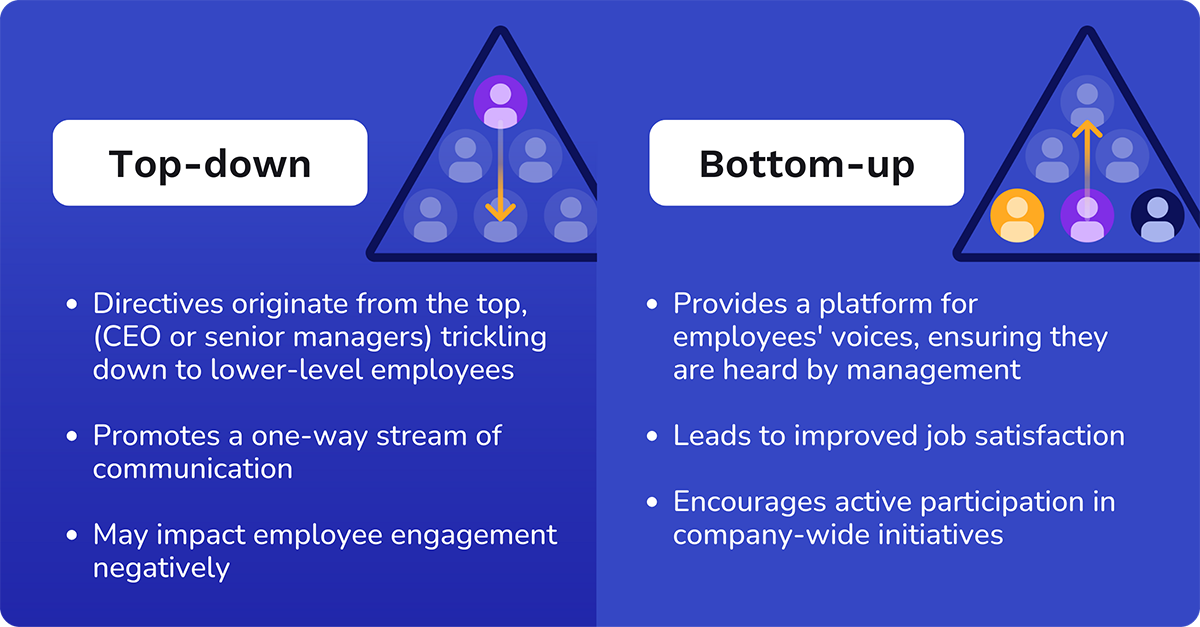Bottom-up communication enables critical feedback from employees and improves decision-making in organizations. Give it a try with our help — free.

.webp)
Effective internal communication is the backbone of every successful organization. Learn the ins and outs of internal communications with our research-backed white paper.
Access NowInternal communication used to be a one-way passage starting at the top. Upper management crafted messages that were funneled through the corporate hierarchy to the employees they wanted to target and inform. Traditional top-down communication, as it is known, is still acceptable for instructions and announcements. But less traditional communication models encourage cross-functional collaboration, providing employees with a voice and the opportunity to give feedback. These include the bottom-up approach, sometimes called upward communication. It is the opposite of traditional top-down communication.
Without any doubt, effective communication within a company is a mighty, often underestimated, tool for success. We’re going to discuss bottom-up communication, the path of communication that stems from employees to management and has a significant bearing on the success of companies.
The aim of this article is to delve into the world of upward communication, analyzing its importance, advantages, and offering strategies to improve it within a 30-day timeframe. By understanding its role and implementing our suggested strategies, it will be possible to fortify your organization's communication framework and reap the resultant benefits very quickly.
The quicker you implement our suggestions and strategies, the quicker you’ll see an improvement.
Much has been written about bottom-up (also known as upward) communication promoting its use and lauding its usefulness. There is also seminal research on bottom-up communication that has contributed to certain core principles that are now embedded in the foundation of internal communication practices.
Studies indicate that bottom-up communication enhances employee engagement and improves decision-making processes. By involving employees in the communication flow, organizations can tap into diverse perspectives, leading to more informed and effective decisions.
Research has found that internal communication practices, including bottom-up communication, significantly influence employees' commitment to the organization. According to Effects of Top-Down, Bottom-Up, and Horizontal Communication on Organizational Commitment (2022), effective upward communication fosters a sense of inclusion and value among employees, strengthening their organizational commitment.
Additionally, analyses of communication patterns within hierarchical organizations reveal that upward communication is essential for maintaining effective information flow and organizational health. Another research paper suggests that communication tends to flow upward more than downward, emphasizing the need for robust upward communication channels. Communication network dynamics in a large organizational hierarchy was first published in 2022 and revised in 2024.
There are also indications that when leaders prioritize communication and shift to “intentional communication,” there are big improvements. Employee engagement is better, there’s improved collaboration and teamwork, teams align more closely with leader vision, and there’s stronger independent decision-making. Essentially, information flows up, down, and around organizations more simply — and therefore more effectively.
Bottom-up communication is a type of internal communication where lower level employees initiate communication, conveying messages and information to upper management. This communication style plays an integral role in enhancing the company culture as it promotes inclusivity and transparency. It also works as an effective internal communication tool in project management.

One of the benefits of upward communication is that it facilitates inclusive conversations and correspondence by enabling rank-and-file employees to share feedback, ideas and concerns with management. This approach aligns with today's flat organizational structures that have few or no levels of middle management. It also promotes subject matter expertise and knowledge sharing.
A classic study undertaken by leadership and organization studies expert Dennis Tourish in 2005 states that critical upward communication improves decision-making in organizations. It enables senior management teams to stay in touch with “the mood of their people,” and identify emerging problems. He also says that two-way communication and critical feedback are vital aspects of organizational success.
The resulting paper, Critical upward communication: ‘Ten Commandments’ for improving strategy and decision making, is a lengthy document that is referred to and cited by many.
It explains how senior management easily becomes out of touch with employees. This results in employee resistance rather than employee engagement. Emphasizing the importance of feedback from employees, he highlights that many managers ignore “critical” feedback but encourage positive feedback.
He discusses the benefits of bottom-up or upward communication and dissent. Despite a growing realization that employee “feedback is essential to effective human performance in any task.” But, he says, there are double standards, and many believe feedback must come from the top down. He talks about the barriers of upward communication, one of which is a fear of feedback from employees. Ultimately, he suggests “ten commandments” for improving critical upward communication.
Quantify the financial benefits of your internal communications

Even in 2005, this was considered a powerful way to institutionalize feedback and integrate it into the established practices, policies, and culture of an organization.
Managers and team leaders need to recognize that some employees will often ingratiate themselves and give positive, rather than critical, feedback. If they don’t, they may be susceptible to inappropriate responses - because no-one is impervious to flattery!
All feedback matters. But there needs to be a balance between positive and negative feedback. The suggestion here is to mistrust positive feedback and concentrate on the validity and solutions of problems and criticisms.
The message here is not to rely on official reports and written communications mediated by management - from the top down. “Back to the floor” initiatives are encouraged.
Even though formal suggestion systems had already been in place for decades prior to Tourish’s research, he discovered that less than half organizations made use of it. The Axios HQ report shows that employees are still struggling to get the opportunity to provide feedback and make suggestions.
The motivation for this is to ensure information isn’t ignored. If it doesn’t reach the right ears, it probably will be ignored. Without upward communication it’s unlikely to get to the right people.
The motivation for this is because, at the time, top-down communication was the norm for team briefings. Instead, communication needs to flow in both directions. It is vital that problems and criticisms are reported from the bottom up.
The lack of appropriate communication skills is a main reason that top managers “disconnect” so often. This is why training is essential.
This is essential for open, two-way communication.
“Organizations that take communication seriously are led by CEOs who take communication seriously.” It’s that simple. The CEO must walk the talk and set an example.
Everything that Dennis Tourish suggests in his Ten Commandments are still more than valid today. Following these ten commandments can give you a head start when you decide to improve upward communication in your organization.

Traditionally, most businesses have used a top-down approach in their communication streams. This management style involves directives originating from the top — from the CEO or senior managers - trickling down to lower-level employees. It is typical in external communications or important change initiatives.
However, the top-down method has been criticized for promoting a one-way stream of communication that may impact employee engagement negatively. It's in these contexts that the bottom-up approach springs to life. This communication form has been likened to a breath of fresh air, allowing lower-ranking personnel to contribute important insights and ideas to upper management.
The bottom-up approach provides a platform for employees' voices, ensuring they are heard by management. This kind of inclusive culture not only leads to improved job satisfaction, but also encourages active participation in company-wide initiatives. Internal communication tools can be excellent resources to manage this information flow.
The primary difference between these two management styles lies in their direction of communication. While both can have a significant impact on corporate culture and productivity, the right choice often depends on the nature and size of the organization. The specific needs of its employees are also vital. In many cases, a combination of upward and downward, top-down communication, can be the most beneficial approach. This is because it allows for structured, yet flexible, company-wide communication.

Here are a few examples of the bottom-up approach in organizations:
The key aspect is information flows from lower organizational levels upwards to give insight, raise issues, or influence decisions. This bottom-up approach ensures staff doing day-to-day work can have their perspectives heard by top management.
Bottom-up communication doesn’t just ensure that everyone’s voice is heard. It also has tangible benefits that can dramatically change your company culture. This communication style often boosts job satisfaction as employees feel that their opinions matter.
Most importantly, upward communication can lead to more effective internal communication across different communication streams. When frontline employees can air out their concerns, upper management can address these more efficiently and make better choices in critical change initiatives. In fact, lower level employees often understand the daily operations of the company better than upper management. This means that their input can be invaluable.
Last but not least, bottom-up communication strengthens external communications too, while single stream top-down communication doesn’t. When employees are well-informed and engaged, they represent the company better. This leads to enhanced public image and improved customer satisfaction. Upward communication then becomes not only an internal communication tool but also a strategy for external success.
While bottom-up communication comes with a plethora of advantages, it needs a proper framework for it to work properly. Much like any other management style, it has to be understood and managed through the use of effective online communication tools. A strong foundation in communication technology goes a long way in ensuring the effectiveness of this form of communication.

It stands to reason that bottom-up communication strategies refer to communication that flows from lower levels of an organization's hierarchy upwards to leadership. These strategies empower employees at lower levels to share ideas, provide feedback, and report problems.
Some examples of bottom-up communication tactics include:
The goal of bottom-up communication is to shift some organizational power and decision-making to employees who are closest to operations, customers, and problems. This allows them to voice concerns and shape future strategy. Strong bottom-up communication leads to more engaged employees and better informed leadership. Unfortunately, many organizations still don’t realize that top-down communication has the opposite effect.
Quantify the financial benefits of your internal communications

Successful bottom-up communication hinges to a great extent on effective internal communication tools. The right tool can streamline communication streams while ensuring that crucial messages reach the intended recipients. It’s of paramount importance that these tools protect the personal information of its users and maintain good data privacy practices in adherence to prevailing laws.
Cerkl Broadcast, an internal communication tool, for instance, is a highly acclaimed platform that fosters both corporate communication and employee engagement. This online communication tool allows you to add users easily and conduct confirmation campaigns while ensuring data privacy.
Communication tools not only foster internal communications but can often complement external communications as well. Many of these tools have features that enable companies to keep their external stakeholders updated on various change initiatives.
However, while choosing a communication tool, it's important to consider the specific needs of individual organizations. The best communication tools should align with company culture and should be robust enough to handle both internal and external communication.
Cerkl Broadcast's internal communication software is tailored for bottom-up/upward communication. It functions as a centralized hub for all forms of communication assets, enhancing accessibility and management, thereby optimizing long-term planning.
Broadcast’s omnichannel capability promotes effective two-way communication, allowing employees to choose their preferred channels for accessing information, whether on-site, remotely, or internationally. The platform also boasts advanced content scheduling features, enabling communicators to strategically plan message timing and frequency.
Additionally, Cerkl Broadcast's versatile platform supports audience segmentation based on criteria such as department, role, or location, facilitating precise and highly effective targeting in communication planning.
By following our guidelines and utilizing the Broadcast platform to expedite the process, you’ll be sure to see an improvement within 30 days.
Cerkl Broadcast provides a comprehensive and thoughtfully designed platform, empowering you to integrate and implement a bottom-up communication system that will elevate your current approach to a new and exciting level. So, whether you already have a communication system running, or need to start from scratch, Broadcast has the solution. At the same time, we know how important internal communication is for business success, and are dedicated to providing people like you with meaningful resources. If you want to learn more about how internal comms and engagement relationships can elevate your business success, download our internal communication white paper now. It’s free.

Quantify the financial benefits of your internal communications
What is bottom-up communication? The bottom-up approach entails the flow of information within an organization that originates from employees and moves upward through the hierarchy, facilitating feedback, ideas, and concerns.
What is an example of bottom-up communication? An example of the bottom-up approach to communication is when frontline employees provide feedback or suggestions to their managers, contributing to organizational improvement and decision-making processes.
What are the problems with bottom-up communication? One challenge with upward communication is the potential for information overload, making it difficult for higher levels of management to efficiently process and act on the influx of diverse input from employees at different levels. Another is that employees sometimes try to ingratiate themselves by giving positive feedback that isn’t necessarily factual.
What is the difference between top-down and bottom-up communication? Top-down communication flows from higher levels of an organization's hierarchy to lower levels, conveying directives and information. The bottom-up approach has messages moving from lower levels to higher levels, involving feedback, ideas, and concerns from employees to management.

Quantify the financial benefits of your internal communications